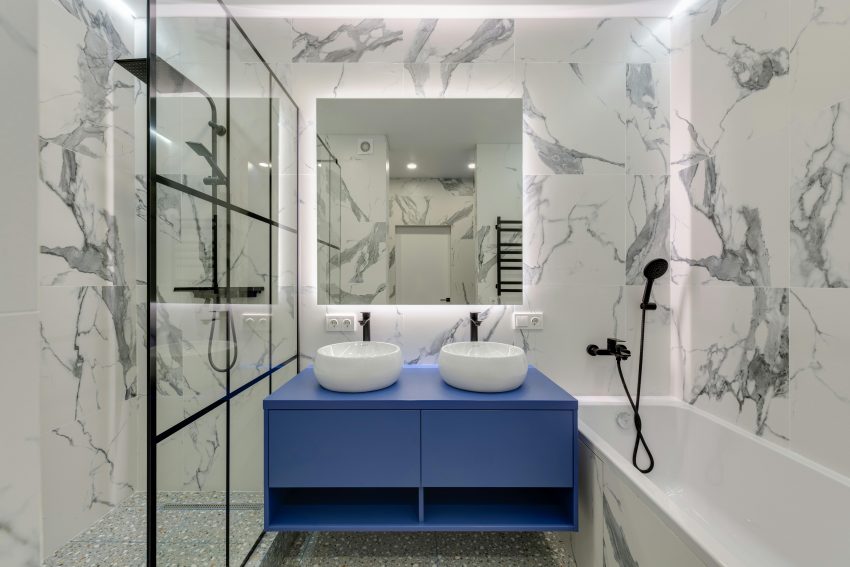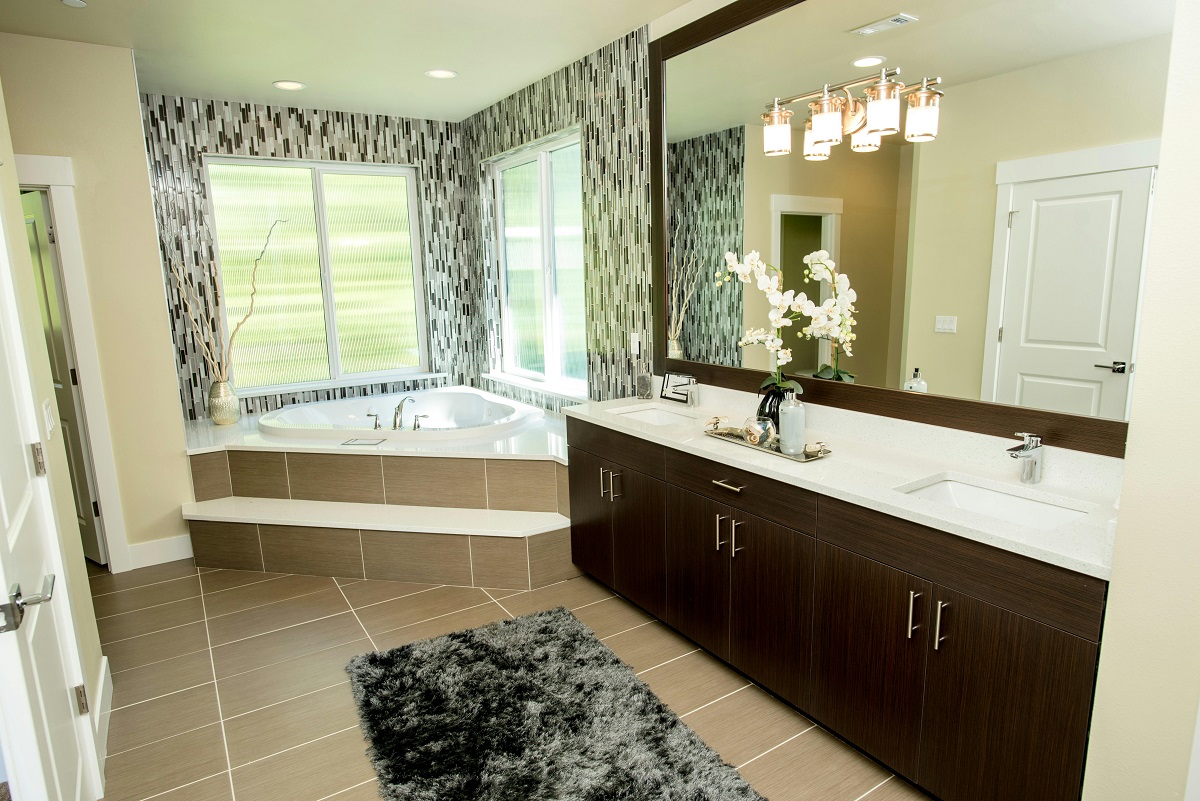
Remodeling a bathroom before you move into your new home can save time, money, and a whole lot of stress down the road. If your new home’s bathroom looks outdated, has water damage, or just doesn’t match your style, tackling the remodel before you unpack can make all the difference. But where do you start?
In this guide, we’ll walk you through everything you need to know—from planning and budgeting to picking materials and hiring professionals. Whether you’re gutting it completely or making simple upgrades, here’s how to make your bathroom move-in ready.
Why Remodel Before You Move In?
You might be thinking: “Can’t I just deal with the bathroom later?” Sure—but there are real advantages to doing it now:
- No daily disruption: You won’t have to work around contractors, dust, or noise.
- Easier demolition: With no furniture or personal items in the way, the remodel goes faster.
- Better results: You’ll have time to do things right—not rush decisions just to get back to using the space.
- Increased home value: Starting off with an updated bathroom adds instant equity.
Step 1: Evaluate the Current Bathroom
Before making any decisions, take time to really study your new bathroom. Walk through it slowly—preferably with a notepad—and look at everything as if you’re a home design professional assessing a client’s space.
What to Look For:
Plumbing Issues
- Check under the sink for water stains, rusted pipes, or musty smells—these can be signs of leaks.
- Flush the toilet and run the shower to test water pressure and drainage.
- Inspect caulking and grout—cracked or missing sections may lead to water damage behind the walls.
- If there’s any bubbling paint or warped floors, there could be a leak behind the scenes.
Layout Inefficiencies
- Are fixtures too close together? For example, does the toilet crowd the tub?
- Is there enough elbow room around the vanity or sink?
- Consider how traffic flows—especially in a shared or family bathroom. If people will bump into each other during the morning rush, that’s a red flag.
Outdated Fixtures
- Is the tub stained or cracked? Are the faucet handles from the 1980s?
- Yellowed toilets, chipped vanities, or plastic towel bars can make the space feel tired and neglected.
- Ask yourself if the current design fits your aesthetic—or if it’s worth updating before you move in.
Lighting and Ventilation
- Poor lighting makes grooming difficult and creates shadows that age the room visually.
- Lack of ventilation is even worse—it can lead to mold, mildew, and peeling paint.
- Look for signs of condensation damage on the ceiling or near the exhaust fan. If there’s no fan at all, put that high on the remodel list.
This evaluation helps you clarify whether you need a full gut renovation or if a targeted refresh will do the trick.
Step 2: Define Your Goals and Budget
After assessing the space, get clear on what you want—and what you can afford. This sets the tone for every decision moving forward.
What Do You Really Want From Your Bathroom?
Make a two-column list: needs on one side, nice-to-haves on the other. Here are some ideas to get you started:
- A larger shower or soaking tub? Consider your lifestyle. If you take quick showers, prioritize shower upgrades. If you dream of spa nights, a soaking tub may be worth the splurge.
- More storage space? Small bathrooms especially benefit from smart storage solutions.
- Better lighting or ventilation? This is key to both comfort and longevity of materials.
- A timeless vs. trendy look? Classic finishes age well, while trendy designs offer character. Find a balance that suits your taste and resale goals.
Budgeting Basics
Understanding the potential costs upfront will save you from mid-project panic.
Common Budget Ranges:
- Cosmetic refresh ($3,000–$6,000)
- New paint, fixtures, lighting, and hardware
- No plumbing or major tile work
- Mid-range renovation ($7,000–$15,000)
- New flooring, vanity, toilet, shower/tub upgrades
- Minor layout changes
- High-end remodel ($20,000+)
- Full demolition and rebuild
- Custom cabinets, premium fixtures, layout reconfiguration
Pro Tip:
Always set aside 10–20% of your budget as a contingency fund. Hidden plumbing issues, mold, or backordered materials can add unexpected costs. Having a buffer gives you peace of mind.
Step 3: Plan the Timeline
Remodeling before move-in means you’re working against the clock. Having a clear timeline helps you coordinate with movers, contractors, and deliveries.
Average Timeframes:
- Simple upgrades (paint, fixtures, new mirror): 1 to 2 weeks
- Full remodel (tile, plumbing, major updates): 3 to 6 weeks
- Projects involving permits or structural work: 6 to 8+ weeks
Keep Your Schedule on Track:
- Order materials early: Vanities, tile, and fixtures can take weeks to arrive.
- Get quotes and book contractors ASAP: Good pros are often booked out.
- Build in buffer time: Don’t expect everything to go perfectly. Delays happen.
- Avoid back-to-back installations: For example, schedule tile installation before vanity delivery to prevent damage.
If your move-in date is non-negotiable, prioritize essentials—like a working toilet and shower—and schedule finishing touches after you’re settled.
Step 4: Hire the Right Help—or DIY?
Depending on the complexity of your remodel, you may be able to take on some tasks yourself—but not all jobs are beginner-friendly.
Should You Hire a Contractor?
If your project involves:
- Moving plumbing or electrical lines
- Tearing down or building walls
- Installing a new tub, shower, or vanity
…then you’ll want a licensed contractor. A good contractor will:
- Pull permits and schedule inspections
- Coordinate subcontractors (like plumbers and electricians)
- Order and manage materials
- Solve problems quickly if something goes wrong
Get multiple estimates and ask for references. And don’t just choose the cheapest option—look for someone who understands your goals and communicates clearly.
When to DIY
There are plenty of tasks that a confident homeowner can tackle, especially if you’re looking to save money:
- Painting walls or cabinets
- Replacing faucets or showerheads
- Installing a new mirror or towel bar
- Swapping out light fixtures (with basic electrical know-how)
If you’ve never done a DIY project before, start small and work your way up. YouTube tutorials and home improvement forums can be lifesavers—but know when it’s time to call in a pro.
Step 5: Choose a Bathroom Layout That Works
Even if you’re not changing the footprint, there’s usually room for layout improvements that make the bathroom more functional and visually balanced.
Smart Layout Tweaks:
- Swap a tub for a walk-in shower: Great for small bathrooms or if you rarely take baths. It opens up the room and adds modern appeal.
- Install a floating vanity: Creates the illusion of more space and makes cleaning easier.
- Switch to a pocket door: Ideal for tight entryways where a swinging door eats into space.
- Reposition the toilet: If plumbing access allows, moving the toilet can dramatically improve traffic flow and aesthetics.
For especially compact layouts—like the classic 5×7 bathroom—focus on minimalism and storage optimization. Every decision should support both form and function.
Step 6: Select Materials and Fixtures
Materials make or break both the look and longevity of your remodel. Choose wisely, especially in high-moisture areas.
Flooring
- Porcelain or ceramic tile: Durable, waterproof, and available in endless styles.
- Luxury vinyl tile (LVT): Mimics wood or stone, but softer underfoot and easier on the budget.
- Natural stone (marble, slate): Gorgeous and long-lasting, but higher maintenance and cost.
Walls
- Waterproof paint: Good for quick updates—make sure it’s mold/mildew resistant.
- Tile wainscoting: Protects the lower walls from water damage while adding elegance.
- Full-tile walls: A bold, clean look—especially in walk-in showers or modern designs.
Fixtures
Stick with water-efficient, long-lasting options:
- Dual-flush toilets to save water
- Low-flow showerheads that maintain pressure
- LED lighting for energy efficiency
- Touchless faucets for convenience and hygiene
Choose a finish that suits your style and coordinates with other rooms—popular options include brushed nickel, matte black, and polished chrome.
Step 7: Maximize Storage and Functionality
Storage is often sacrificed for aesthetics—but it doesn’t have to be. With a little planning, you can have both.
Smart Storage Solutions:
- Recessed medicine cabinets: Offer sleek, hidden storage without taking up extra space.
- Drawer organizers: Keep everyday items like razors and makeup neat and accessible.
- Floating shelves: Add visual interest and display space for towels or decor.
- Over-the-toilet units: Use vertical space wisely, especially in small bathrooms.
- Built-in shower niches: No more cluttered caddies or slippery shelves.
Before you finalize the layout, ask yourself:
- Who’s using this bathroom? Kids? Guests? Just you?
- Do you need outlets inside cabinets for grooming tools?
- Is there space for laundry baskets or hampers?
- Will towels be stored inside the bathroom or nearby?
The more your bathroom supports your daily routine, the more satisfied you’ll be with the remodel.
Step 8: Add Style and Personality
Now that the bones are solid, bring the space to life with color, texture, and detail.
Easy Ways to Add Personality:
- Fun tile patterns: Try herringbone, chevron, or geometric tiles for the floor or shower wall.
- Statement mirror: Go beyond the builder-grade rectangle. Round or arched mirrors can soften the look.
- Unique lighting: Sconces, pendants, or even a mini chandelier can add drama and warmth.
- Accent color: Use paint, towels, or accessories to add a pop without committing to a bold tile.
- Art or plants: Framed prints or low-light plants like ferns bring life and a spa-like touch.
Keep in mind: it’s easier (and cheaper) to change out decor than it is to redo tile or fixtures, so use trendier elements on items that are easy to swap.
What About Permits?
Not every remodel needs a permit—but many do. Check with your local building department if your remodel includes:
- Moving plumbing or electrical lines
- Installing new windows or vents
- Tearing down or building walls
- Structural or layout changes
Why Permits Matter:
- They ensure work is up to code
- They protect you during resale
- They reduce safety risks
If you’re hiring a contractor, they should pull permits for you. If you’re DIYing, call your city office before starting—some even offer online applications and checklists.
Should You Remodel Every Bathroom Before Moving In?
Not necessarily. If you have multiple bathrooms, start with the one you’ll use the most. That’s usually:
- The primary (master) bathroom
- Or the only full bath in the house
You can always schedule secondary bathroom upgrades later—especially if you need to move in sooner or keep your budget in check.
How to Remodel a Bathroom Without Costly Mistakes
To get the best results, watch out for these common mistakes:
- Underestimating the timeline – Delays happen. Build in extra time.
- Choosing style over function – A pretty bathroom that doesn’t work well won’t stay pretty for long.
- Forgetting ventilation – No exhaust fan? Prepare for mold issues.
- Using the wrong materials – Not all flooring or paint is suitable for wet areas.
- DIYing plumbing or electrical without experience – Can lead to costly (and dangerous) mistakes.
Sample Bathroom Remodel Timeline (Before Move-In)
Here’s how you might schedule a mid-range bathroom remodel before moving in:
| Week | Task |
| Week 1 | Finalize design, hire contractor, order materials |
| Week 2 | Demo and rough plumbing/electrical |
| Week 3 | Tile installation, wall prep |
| Week 4 | Fixture installation, painting |
| Week 5 | Final touches, cleaning, walkthrough |
Always leave buffer time before your move-in date just in case something runs behind.
Final Thoughts: Is It Worth It?
Remodeling a bathroom before you move in can feel like one more thing on a never-ending to-do list—but the payoff is real. You’ll start life in your new home with a space that works for you, looks the way you want, and won’t need fixing anytime soon.
Whether you go all out with a full gut renovation or just update key features, planning ahead is the key to success. Take it step-by-step, get the right help, and don’t rush the process.
When you’re soaking in your new tub or brushing your teeth under flattering light and fog-free mirrors, you’ll be glad you made the investment before move-in day.



